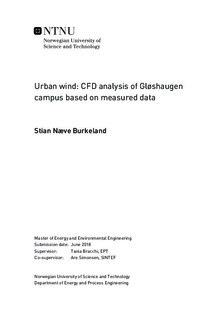Urban wind: CFD analysis of Gløshaugen campus based on measured data
Master thesis
Permanent lenke
http://hdl.handle.net/11250/2561817Utgivelsesdato
2018Metadata
Vis full innførselSamlinger
Sammendrag
In this study, a CFD analysis of the wind condition at the Norwegian University of Science and Technology based on local measurements is conducted of inlet wind profiles. The simulation is performed on Abel computer cluster, with ANSYS Fluent as simulation tool and $k-\epsilon$, $k-\omega$, and LES as turbulence models. The aim of the analysis is based on finding most promising sites for wind turbines and characterize differences in the turbulence models based on turbulent parameters at the inlet.
Five wind measurements have been carried out at the campus, three of them were located at the inlet of the computational domain, while the two others were located inside the campus. The inflow condition is estimated based on the three measurements at the inlet, while the two others have been used to validate the simulation results numerically. Both RANS models and LES predicted a higher mean velocity at the two measurement location inside the campus compared to the measurements. However, a hit rate value for the simulated results was larger than $66$ $\%$, meaning that the simulation is applicable for predicting the flow through the university.
Furthermore, preliminary analysis of the most promising building for siting wind turbines, based on high-velocity and low-turbulence regions. It was concluded that the high-rise building at the center of the campus was the most suitable location for wind turbines. Based on this, a more thourogh analysis of the effect of different inlet parameters on flow conditions at this location was carried out.
The simulations are carried out with turbulence intensity at the inlet equal to $0.1$, $5$ and $10$ $\%$ for the RANS models, and No Perturbation and $5$ $\%$ for the LES model. The mean velocity calculated by both RANS models and LES model above the building was not affected by different turbulent inflow condition. While the turbulence intensity distribution for the RANS models was highly increased as the turbulent intensity at the inlet was increased. Additionally, the turbulent length scale at the inlet was analyzed based on two hydraulic diameters at the inlet, $50$ and $100$ meters respectively, for the $k-\epsilon$ simulation. It was shown that turbulent length scale at the inlet does not influence the velocity and turbulence intensity downwind of the domain. Based on the findings from the CFD simulation, some recommendation is performed for most promising sits for wind turbines.
